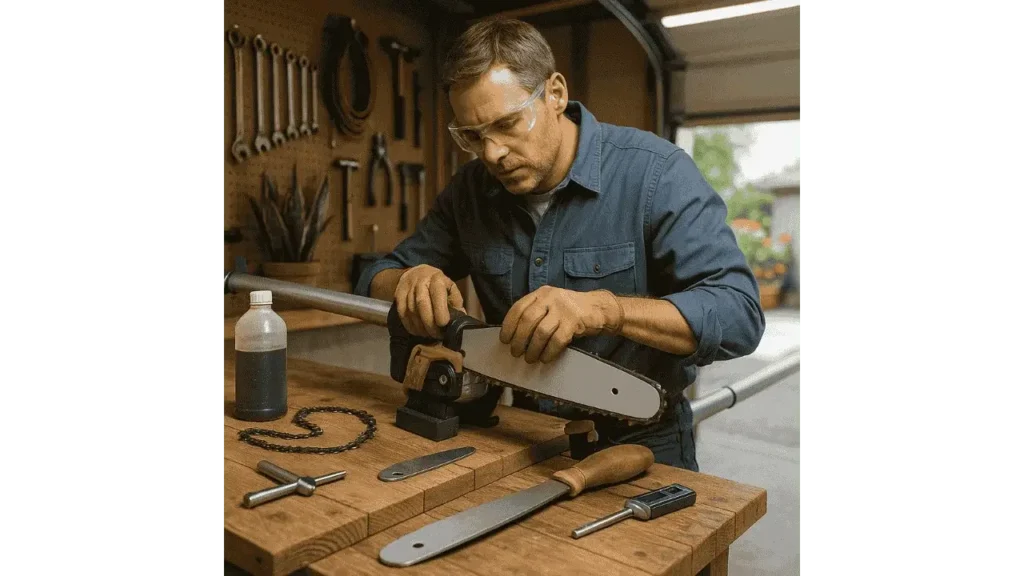If you’ve ever found yourself reaching just a bit too far with a pole saw, it might be tempting to upgrade to a longer bar. But can you safely and effectively install a longer bar on a pole saw? The short answer is: not usually, unless every component is perfectly matched. Let’s examine how bar sizing works, what constraints matter most, and what risks you need to weigh before attempting an upgrade.

How Pole Saw Bars Differ from Chainsaw Bars?
Stock Bar Lengths & Mount Fit
Most pole saws come with stock bar lengths between 8 and 12 inches. These bars are designed to balance weight, control, and motor capacity. Pole saw bar mounts are often proprietary, meaning that even if another bar is the right length, it might not fit your specific model. Always check the mount type and bolt pattern before considering any modifications.
Engine Power Constraints
Pole saw motors, whether electric, battery-powered, or gas, are typically less powerful than full chainsaws. They’re engineered to handle lighter loads at extended reaches. Extending bar length increases resistance, and many motors simply aren’t rated for the extra strain. Overloading can cause early failure, poor cutting performance, or overheating.
When a Longer Bar Might Work
Perfect Match of Specs Required
In rare cases, users have successfully installed a longer bar by ensuring an exact match across all components. Outdoor tool technician Lana Ortiz notes,
“We get a lot of questions from homeowners wanting to extend their pole saw’s reach, but unless everything lines up perfectly, it’s usually more trouble than it’s worth.”
This means the mounting slot, chain pitch, gauge, sprocket configuration, and oiler system all need to align perfectly. Even then, performance isn’t guaranteed, especially if the power source isn’t strong enough to support the larger bar.
Potential Trade-Offs
Longer bars add weight, making the saw harder to control at extended lengths. This can lead to faster user fatigue and a higher chance of imprecise cuts. The saw may also feel unbalanced, which increases handling difficulty. And while a few extra inches might seem useful, you may lose more in safety and maneuverability than you gain in reach.
Real-World Experiences & Warnings
Known Fit Limitations
Even within the same brand, bar compatibility can vary. For example, a 12-inch bar from a chainsaw model might not fit the brand’s pole saw variant. In many cases, users report partial fits, where the bar technically attaches, but the oiler doesn’t work properly or the sprocket mismatch causes chain slippage.
Professional Advice
Certified arborist Tom Reed explains,
“We see a lot of tool failures that start with improper bar swaps. A longer bar might seem like a shortcut, but it often ends up shortening the tool’s life.”
Manufacturers design pole saws as a complete system, and altering one part often creates unintended problems.
Safety & Performance Considerations
Handling and Control Challenges
A longer bar means more leverage, and not in a good way. It shifts the balance of the saw, which can make it harder to hold steady, especially when trimming at full extension. If your saw becomes harder to control, precision drops, and safety risks go up.
Risk of Kickback or Motor Overload
Kickback risks increase with longer bars, particularly if the motor struggles to maintain chain speed. At full reach, your reaction time is reduced, so any sudden bind or snag can become dangerous fast. Motor overload is another concern; adding a longer bar increases the load, and if the motor isn’t designed for it, you risk overheating or permanent damage.
Final Takeaways
Bar size isn’t just about cutting capacity; it’s matched to motor power, safety specs, and weight distribution. Sticking with OEM specifications is the safest and most reliable approach. If you’re set on extending your bar, check that every technical detail matches, including chain specs, drive links, mount shape, and oiling system compatibility.
Even with a perfect fit, longer bars reduce maneuverability and increase stress on the saw. If reach is your issue, consider an extendable pole saw or a professional-grade model built for longer bars.
- How Many Watts Does a Circular Saw Use and Why Does It Matter? - December 1, 2025
- Can You Cut Acrylic With a Circular Saw Safely and Cleanly? - November 29, 2025
- Which Way Does a Circular Saw Blade Go on Your Saw? - November 28, 2025
